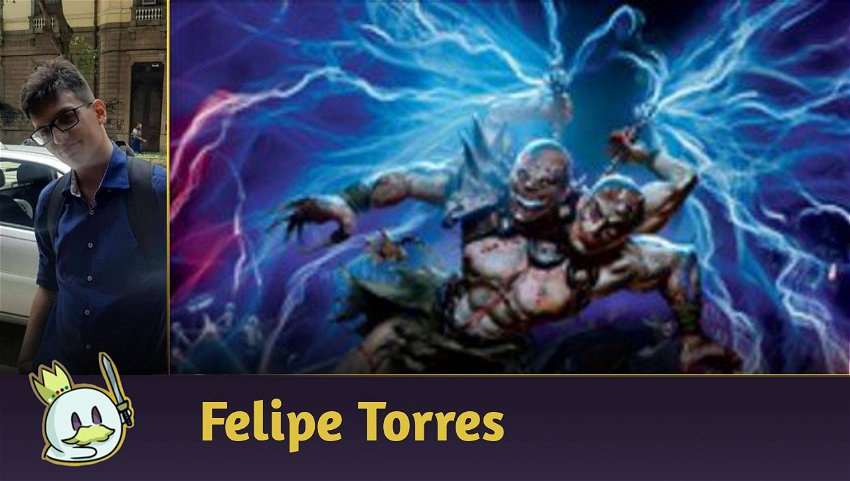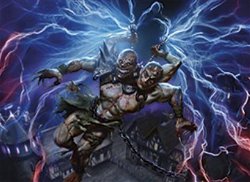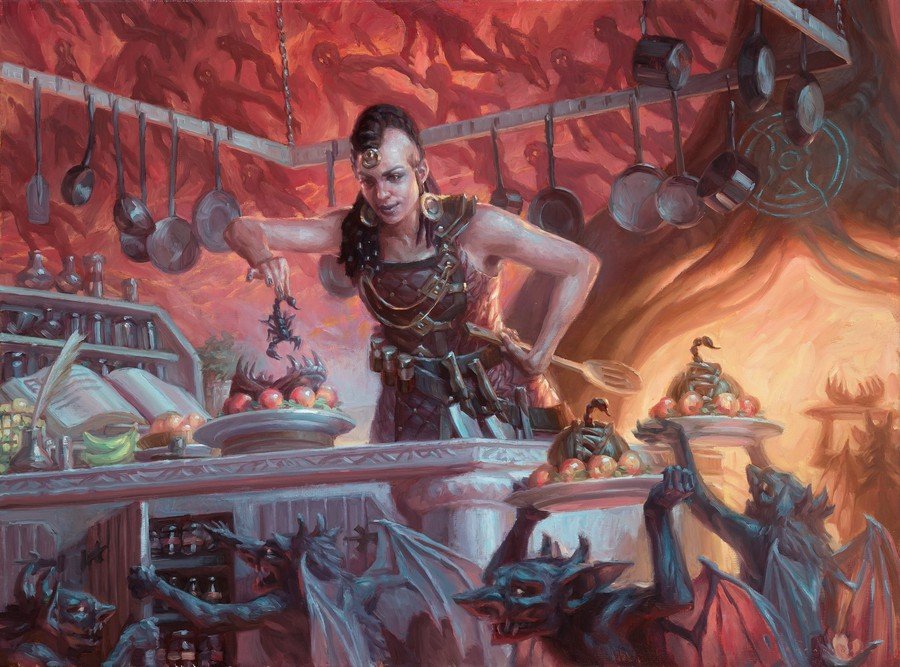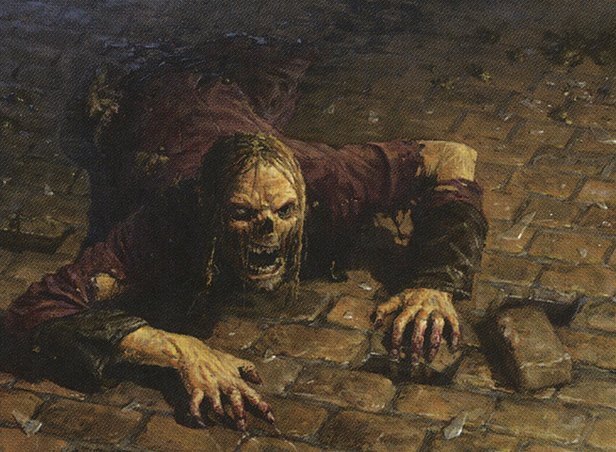I hope this article encourages players who have never ventured into cEDH's tier 1 or 2 decks, using different but competitive lists.
The decklist used in this article is an adaptation of a list assembled by the player ano__2k.
The List
Commander Analysis

At first, we will look at Kraum, Ludevic’s Opus. It costs 5 mana, three colorless, one red and one blue, and by the number of rituals and ramps in the deck it can be played early with consistency.
Ad
It flies and has haste, which allows you to hit it on the turn it enters and reduces your opponents' life so that they don't abuse so much of Ad Nauseam and other effects that cost life, besides allowing you to draw cards every time an opponent casts the second spell on the turn.

Now is the time to look at Armix, Filigree Thrasher. It costs three mana, costing two colorless and one black mana, and works as a command zone removal, but requires you to discard a card for it, and this effect is only activated when Armix attacks.
The synergy of the two commanders is clear; while Kraum draws you cards, Armix gives you a new way to use them. Armix as a commander is good, but it's essential to have this counterpart that grants some card advantage.
Winning Games
This deck uses some combos to finish the game, but all of them are based on winning by casting Thassa's Oracle and ways to exile or mill the deck.
Thassa/Consult

Combo Condition: Thassa's + Consultation or Tainted Pact in hand and enough mana to cast them.
You cast the tutor who has named a card you don't have in your deck, after that, you cast Thassa's Oracle and win the game with its ETB ability.
Breach Freeze

Combo Condition: Underworld Breach in hand, Brain Freeze, and Lion's Eye Diamond in hand or graveyard, and at least 4 mana available, one blue and one red, the others two do not need to be colored.
You cast Breach with it on the board, if you have LED in your hand, cast it, if not, cast Freeze. (Casting the LED before increases Storm Count and increases number of milled cards). If the non-LED has already been cast, use it to generate 3 blue mana, use that mana to cast Freeze, milling even more cards, and repeat this process until you are basically out of cards in the library, when that happens, cast Freeze, giving target one of your opponents, repeating the LED process to generate mana, and mill all opponents.
If your opponents have some way to avoid losing by mill, use the Thassa’s Oracle in your graveyard to win the game during your turn. If you don't have Brain Freeze, you can mill cards with Grinding Station using the positive mana stones or even those that generate the same amount used to cast it, until you mill Brain Freeze or some tutor to find it.
Reasons to choose this deck
This deck works like a "glass cannon"; it can be very aggressive, but doesn't have many tools to protect itself. Like many of the other cEDH lists, this one also abuses the three colors that are currently strongest and most relevant in the cEDH to have good quality and consistency in its packages and answers.
It's a list that abuses Ad Nauseam and Peer into the Abyss on a set of Wheels when it can, and Hullbreacher's ban has left this type of deck without such an effective punitive answer, you not having the card and your opponents not having it either makes it easier to take advantage of this strategy.
Ad
The list does not seek to deal with the current metagame, but rather to ally with it while trying to remain unnoticed by opponents until you have enough tools to win. However, unlike other decks that aim to abuse this meta, the late game here is still a little stronger due to cards like Bolas's Citadel that can guarantee a strong value to achieve victory.
Initial considerations
Here I will talk a little about some decisions that were made in this decklist, such as the reduced number of lands. This was a decision made with the aim of maximizing the usability and usefulness of the deck's slots, thus preventing you from having several lands in your hand, even if you end up with only one or two on the field. The deck doesn't need many lands to maintain itself, normally the cEDH decks use 29 lands, but the official list of this deck has even less lands counting with only 25, 26 if counting the card which one of its sides is a land.
In my tests with the deck, I chose to make two changes to update the list.
The first change was the removal of Hullbreacher, as it was recently banned and the list hasn't been updated, and I put a land in its place, Mana Confluence.
The second change was the removal of Sidisi's Faithful to add a strong card from Modern Horizons 2, Ragavan, Nimble Pilferer, which plays various roles in the deck, and can generate mana in the form of treasures or generate card advantage with the cards exiled from the opponent's deck, all at the same time and for just one or two mana, if the monkey's Dash is used.
Analyzing the deck's packages
As this deck aims to maximize the usability of each slot, many cards defined for this list fit into more than one pack and can be used in different situations. Its packages are: Ramps, Rituals, Tutors, Card Advantage, Wheels, Removals, Interactions and Counters.
Ramps

A large part of a cEDH deck consists of ramps and rituals to speed up the game, so all the positive mana stones and a few not so optimized have been included. We go from Mana Crypt and Mox Diamond to Talisman of Indulgence, but in this list there are some new choices like Birgi, God of Storytelling which grants you a red mana every time you cast a spell, virtually doubling your mana, even more so if you consider that many of the spells cost one or zero mana.
Ragavan, Nimble Pilferer is the absurdly strong new card in every format it can be played in, it can generate treasure every turn, which frames it as a ramp because it can generate mana and keep it stored for when needed.
Rituals

Ad
This package usually works like a ramp, but usually only once, depending on other cards to generate more mana later.
Usually, other effects need to be used, or other cards cast together to profit from their effects. Cards like our friend Dockside Extortionist which generates treasure in its ETB, Jeska's Will which generates mana according to the number of cards in an opponent's hand, Snap which can bounce a creature and untap your lands, Lion's Eye Diamond which is sacrificed to generate 3 mana at the cost of discarding your hand, Culling the Weak which generates 4 mana if you sacrifice a creature, plus rocks that doesn't untap, all this to increase your available mana in the early turns of the game and keep a stable board, or take an explosive turn to try to win.
Tutors

In cEDH, the decks needs to have a lot of consistency because even almost all the lists are abusing cards outside the curve, if your opponent starts the game with a very aggressive hand and ends up getting way ahead of the opponents, it can be difficult to deal with.
So, it is important to have a large density of easily abused cards, together with a package of twelve tutors, of which almost all are general, both for the hand and for the top of the deck; Entomb and Gamble to the Graveyard, Praetor's Grasp to abuse that card from the opponent's deck and prevent them from using it, Transmute Artifact which can fetch any artifact from the deck, paying an amount of mana equivalent to the difference in mana value between the artifacts, if the searched artifact has a higher mana value than the sacrificed artifact, and putting it into play
Remember that the list has Tainted Pact and Demonic Consultation, which, in addition to being able to search for cards from your list, also serve as part of the main wincon of this decklist.
Card Advantage

This list focuses on cards that either have two excellent effects and one of them grants card advantage like Ragavan, Nimble Pilferer which generates cards in hand in the form of cards exiled from the attacked opponent's deck and which can be cast, and also works as a ramp because it generates treasure, the other side of Birgi, God of Storytelling, the Harnfel, Horn of Bounty, can generate advantage in the form of exiled cards, which has a lot of synergy with LED, which discards your hand to generate mana, and this card can use that mana even with no cards in hand.
Notion Thief is the closest thing to a Hullbreacher that we will have after its banning. We also have cards that generate cards in the hand very efficiently such as Ad Nauseam, Peer into the Abyss, Bolas's Citadel, and Necropotence that exchange life for extra cards in hand or on the field, and also Mystic Remora and Rhystic Study, which can punish and tax your opponents' spells by guaranteeing you cards in hand or increasing the cost of opponents' spells if they don't want you to have this card advantage.
Ad
Wheels

Wheels are strong with or without the aid of cards that make them even more powerful for those who use them.
Giving a moving hand to all players is a negative thing, but this kind of play is more recurrent after using hand tutors or to contain one of the opponents with many cards in hand, not to mention cards that can abuse or defend from wheels very well like Notion Thief, and prevent your opponents from having those extra cards, and still make them discard part or all of their hand.
Removals

As I said before, few slots can be entirely dedicated to just one function. All cards defined as removals actually work as bounces, as this deck is not intended to control the game, but to remove small problems from the field when necessary or protect itself when opponents try to interact with Thassa's Oracle. It is often better to return the card to your hand than to lose it.
Unsubstantiate can protect your spells, taking them back to your hand when needed. On top of all this, there is the interaction between Dockside Extortionist and bounces that allows you to have more ETB triggers to generate treasures. We also have cards like Shatterskull Smashing, which can act as land, or when you already have a good amount of mana available, can be used to remove more than one threat on the field at the same time.
Interactions

Counters and interactions are essential to protect yourself when trying to win games and as a way to prevent your opponents from winning games.
To optimize these responses, they should cost as little mana as possible, so we have cards like Force of Will, Fierce Guardianship, Pact of Negation, and Mental Misstep, which can counter spells without paying a mana cost at the time they're cast, plus Flusterstorm and Swan Song are optimized counters.
When you intend to win the game on your turn, one way to make it harder for your opponents to interact is to use Defense Grid to increase the cost of their answers and protect your path to victory.
Strengths & Weaknesses
Strengths
The deck can impose its rhythm easily, its number of ramps and rituals can make your turns very explosive, which makes it very difficult for your opponents to interact. The number of tutors in this deck, keeps its consistency high and for low mana, allowing you to transition your way of playing during the game without many consequences.
Weaknesses
This list has only a few ways to deal with your opponents, which is a problem, but that was a decision made by the list creator in an attempt to maximize its speed. The fact that it has few interactions and answers is precisely to spend more resources developing the game itself instead of trying to stop opponents.
Ad
If you spend your interactions while your opponents are trying to win, and you run out of answers to protect the combo itself, you might lose the game. With this list, it is critical to know when not to interact with opponents, as the deck's number of answers is limited.
Conclusion
I close this article here, stay tuned that soon we will have another cEDH deck guide with interesting choices!
This list is an adaptation of a list that was put together by player ano__2k and placed in the cEDH decks database, cEDH_DDB.
I also leave the link to the original list.










— Comentarios0
Be the first to comment